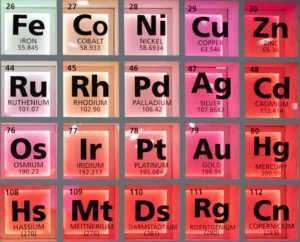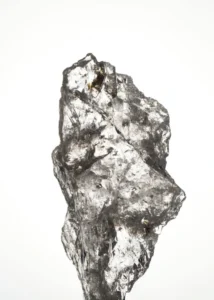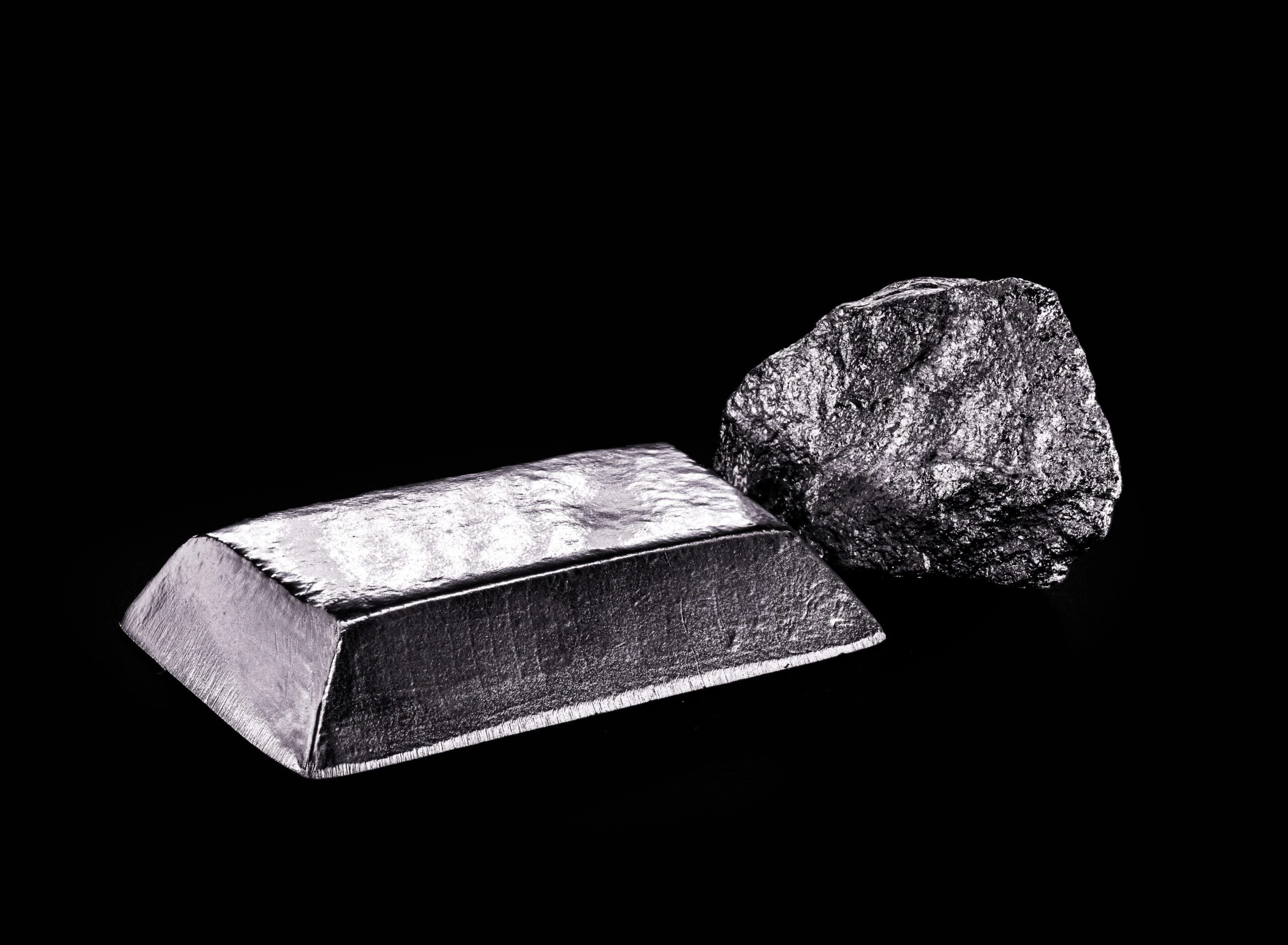Platinum group metals (PGMs): where do they come from, and where do they go? Are we running out of platinum, palladium, and other PGMs? Let’s take a closer look at this highly sought-after group of elements.
The platinum group metal family consists of the following:
The Platinum Group
These six metals are clustered together on the periodic table of elements because they have similar atomic structures and chemical properties. They occur together in nature, commonly found in the same mineral deposits.

PGMs are remarkably versatile, with applications across a wide range of industries – including the automotive, chemical manufacturing, electronics, jewelry, dental/biomedical, environmental, pharmaceutical, and aerospace sectors. (We could list more; those are just the highlights!)
According to the International Platinum Group Metals Association (IPA), about 25% of all products manufactured contain a PGM or used a PGM during production. That’s an impressive amount of PGM use, especially considering that these metals aren’t exactly easy to come by. In fact, PGMs are among the rarest elements on earth. Platinum is 15 times rarer than gold!
Why Are PGMs Important?
PGMs like platinum and palladium are largely known for being used in jewelry and auto parts like catalytic converters. But jewelry and cars just barely scratch the surface of their many functions – here are a few PGM applications that may surprise you:
- Platinum has a range of uses in medicine, including cancer treatments
- Many electronic products – from smartphones to routers and modems – contain palladium
- PGMs are used to create thermal blankets, an advanced type of insulation material used in space exploration
- PGMs are used in almost all vehicles, from locomotives to aircraft, marine vessels, construction equipment and more. If a machine burns fuel, there’s a good chance it uses PGMs.
What Do All PGMs Have in Common?
PGMs are known for their high melting points, durability, corrosion resistance, and catalytic qualities. These traits make them incredibly useful. In certain applications, different PGMs can be used interchangeably. For example, palladium has been used as a substitute for platinum in gasoline-engine catalytic converters because it has been more cost effective at times.
While the six PGMs certainly have key similarities, each one is still unique with its own distinct traits.
Platinum
Platinum is the most well-known of the PGMs due to its use in luxury jewelry. Interestingly, platinum jewelry is more expensive than gold jewelry, even though gold has a higher market price. Platinum is more difficult for jewelers to work with due to its high melting point. Even though platinum was discovered in ancient times, it didn’t become a popular jewelry material until the 19th century.
Platinum is also traded as an investment asset, though not to the same extent as gold and silver. The primary industrial use of platinum is in automobile catalytic converters, but the metal also has medical and electronic applications, among many other uses.

Palladium
Palladium, another well-known PGM, shares many uses with platinum, particularly in automotive catalytic converters. It’s also used in electronic components for cars and other products. As vehicles become more computerized, palladium’s role in control systems and sensors continues to grow.
It’s also used in jewelry, valued for its silvery-white appearance and lighter weight compared to platinum. Fun fact: palladium has the lowest melting point among the PGM family, although it’s still higher than that of most other metals.
Iridium
Iridium is the rarest of the PGMs, which is reflected in its market price: one ounce of iridium is currently worth $3,400! It’s also the most corrosion-resistant metal in the group. Iridium is frequently used as an alloying agent, often to strengthen other metals like platinum. And similarly to platinum, iridium has many medical applications – like cancer treatments and hearing aid implants, just to name a few.
Rhodium
Rhodium is the most expensive PGM, currently clocking in at $5,000 per ounce. As a highly active catalyst, rhodium is widely used in catalytic converters, just like palladium and platinum. Rhodium’s high melting point and temperature make it useful in glass manufacturing as well.
Osmium
Osmium is the densest and hardest of the PGMs. It’s an excellent conductor of electricity and a suitable oxidation catalyst. Osmium’s industrial applications include fuel cells and forensic science. It also serves as an additive in platinum and iridium alloys.
Ruthenium
Ruthenium is known as an excellent alloying agent for other PGMs like palladium and platinum. Despite being relatively brittle, this precious metal has a high melting point and excellent catalytic properties. Ruthenium primarily serves in electrical and electrochemical applications because of its superb conductive properties.

Are PGMs Abundant in Space?
You may have heard that while platinum group metals are rare on earth, they’re plentiful throughout the rest of the universe. While there are some caveats to consider, there is definitely evidence to back these claims.
Scientists have found that certain types of asteroids and meteorites contain significant amounts of PGMs. For example, of iron meteorites that have been studied, the average PGM concentration is 6-230 parts per million. And asteroids, especially M-type asteroids, have also been identified as promising sources of PGMs, along with other precious metals like gold.
However, it’s important to note that PGM concentrations are not uniformly high across all asteroids – the most promising levels are likely found in specific bodies or metal-rich layers. Plus, extracting PGMs from asteroids and meteorites remains a significant challenge. These metals are often embedded within mixtures of other elements, therefore advanced and energy-intensive technologies are required for extraction. But who knows, asteroid mining may be a common practice some day!
Earth’s PGMs: Supply and Demand
Most of the world’s PGMs are mined in just a few countries, with South Africa and Russia being the dominant producers. This heavy reliance on just a few regions makes the PGM supply chain more vulnerable to disruptions.
Throughout the past several years, platinum demand has far exceeded supply. The World Platinum Investment Council is forecasting a platinum market deficit of 848,000 ounces this year, following shortfalls in 2023 and 2024.
Recycling may serve as one of the top solutions to address the deficit. In 2023, recycling accounted for 25% of the total global supply of PGMs, with the remainder coming from mining. And while 25% is a significant amount, there’s certainly still room for growth in recycling efforts.
This is where precious metals refineries like Garfield come into play. We buy metal scrap materials containing platinum and palladium, and then refine and recycle the precious metals, returning them to the supply chain!
With over 133 years of precious metals expertise, Garfield is North America’s trusted leader in refining. Known for high payments and award-winning customer service, we help dentists, jewelers, pawnbrokers, and individual sellers get the most for their precious metal scrap.
If you have unwanted precious metals like gold, silver, platinum or palladium that you’re looking to sell, fill out this form to get started today!

